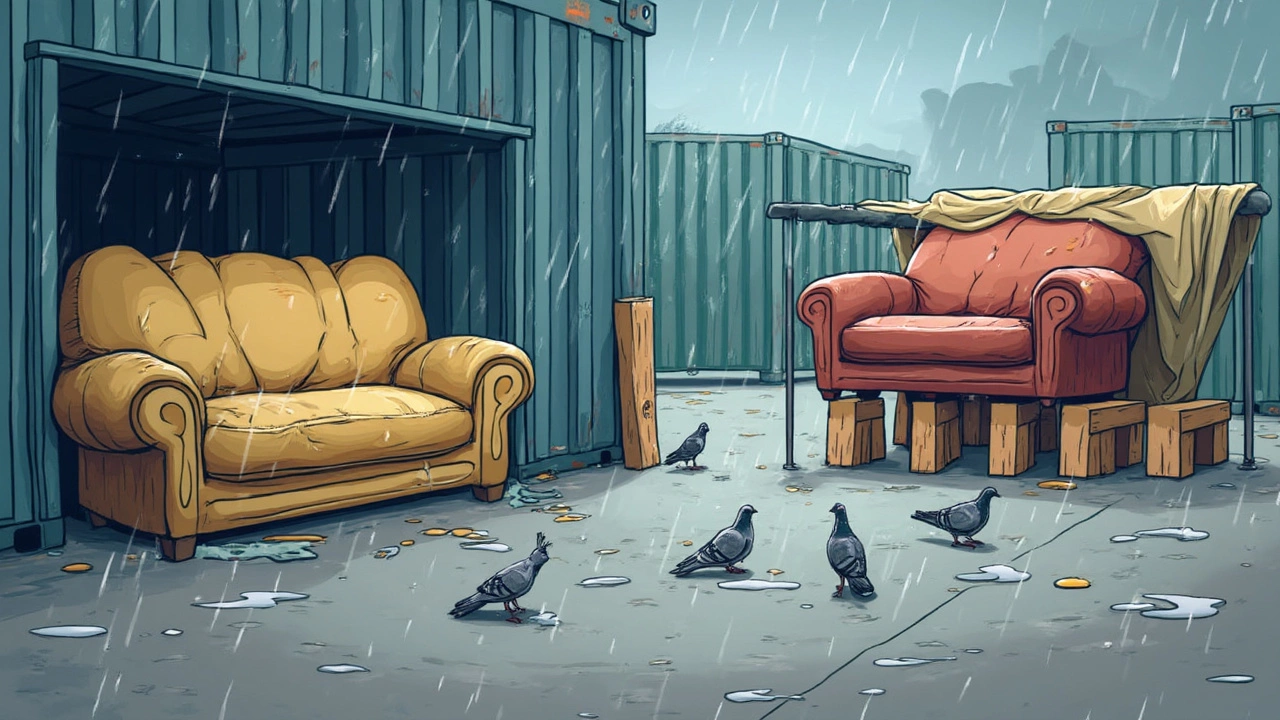Imagine you finally find the perfect couch after months of scouring furniture stores and online marketplaces. You bring it home, and it fits just right. But then life happens—you move, renovate, or need the space for something else. Now you’re faced with a harsh reality: storing your beloved couch. Here’s the kicker—one misstep, and it could end up smelling musty, covered in dust, or worse, home to a tiny army of pests. If you’ve ever seen a saggy, dusty, warped sofa dragged out of storage, you know what’s at stake. Don’t worry, you’re definitely not alone in trying to figure out the best move. There’s a ton of confusion about whether or not you should wrap a couch for storage, what to wrap it with, and how to avoid the classic mistakes that turn storage into a nightmare.
Why Wrapping a Couch Matters for Storage
Storing a couch without proper protection is almost like leaving your ice cream out on the porch in July. Couches are vulnerable to everything in a storage environment: dust, moisture, mold, pests, and fading sunlight sneaking through windows. Even temperature swings can mess with fabrics and frame materials (think sticky vinyl or cracked leather). Not wrapping your couch can shave years off its life, and honestly, you’re risking ugly stains and smells that never quite come out, no matter how many times you Febreze it.
Here’s something most people miss: a couch often spends months (sometimes years) in storage, sitting totally still. Unlike your clothes, that can air out or get washed, couch cushions and fabric just absorb whatever’s floating around. That means airborne dust, mold spores, and moisture droplets can work their way deep into the cushions. Left unchecked, these tiny invaders do real damage—mold, mildew, unwanted odors, and even fabric rot.
Numbers don’t lie. A report from the Institute of Inspection, Cleaning, and Restoration Certification (IICRC) found upholstery absorbs up to 40% of its weight in humidity if left unprotected in non-climate-controlled storage. Another study from a major self-storage company found that 80% of furniture comes out of storage with at least one permanent stain or faded patch if not covered properly. That’s proof enough that wrapping isn’t just optional—it’s crucial.
So, what’s the main reason to wrap a couch? Simple: you want it to come out looking and smelling the same as it did going in. There’s nothing more disappointing than uncovering your couch, hoping for comfort, only to get a whiff of mildew or spot some fresh scratches.
Materials: What Should You Actually Use to Wrap a Couch?
Once you’re convinced wrapping is the right move, the next big question is: what exactly do you use? Not all wrapping materials are created equal, and some can actually *hurt* your couch more than they help. Ever peeled off a sticky sheet of plastic from a vinyl couch, only to find the color stuck to the wrap? Or found mold spots under a too-tight plastic cover? It happens more than you’d think.
The obvious go-to for most people is plastic wrap—those giant rolls of shrink wrap movers love. They’re great at keeping out dust and moisture, right? True, but if you skip the right prep or wrap too tightly, you actually create a perfect storm for trapped humidity and mold. You want to choose materials that allow the fabric to breathe, not suffocate.
Here’s a quick rundown of good options:
- Moving blankets: Thick, padded, and reusable. They cushion the couch and let air circulate. Place them directly against fabric if possible.
- Plastic wrap: Only as an outer layer, after using fabric or a moving blanket. Prevents major dust or spills, but never directly on leather or delicate textiles.
- Fitted couch covers: Made specifically for storage, some are breathable and water-resistant, and protect from scratches. Not all covers are equal, so check material labels.
- Old cotton sheets: Better than nothing if you’re in a pinch. They keep dust at bay but can’t stop spills or high humidity.
- Cardboard corners or pads: Protects armrests and feet from bumping around in transit and in tight storage units.
Never use cling film (kitchen plastic wrap), garbage bags, or vinyl that locks in moisture—those turn your couch into a sauna. This is especially bad for leather, which needs to "breathe." If you’re worried about waterproofing, invest in a furniture-specific cover or make a breathable “sandwich” with blankets and then lightly wrap the whole thing in plastic.
For those who love data, check this quick comparison:
| Material | Protection Level | Breathability | Best For |
|---|---|---|---|
| Moving Blanket | High | Excellent | Any couch fabric, delicate surfaces |
| Plastic Wrap | Medium/High | Poor | Outer layer only |
| Fitted Cover (breathable) | Medium | Good | Long-term storage |
| Cotton Sheet | Low/Medium | Excellent | Short-term/Low risk |
| Cling Film/Garbage Bag | Low | Poor | Not recommended |

How to Wrap a Couch for Storage: Step-by-Step
If you just toss a blanket over your couch, toss it in a unit, and call it a day, you might regret it later. The right approach makes a huge difference. Let’s break it down:
- Clean Thoroughly: Give the couch a proper cleaning. Vacuum cracks, wipe down surfaces, wash removable covers if possible. A little upholstery cleaner goes a long way. Let everything dry completely before you go further—it’s the easiest way to dodge mold and odors.
- Disassemble What You Can: Take off legs, cushions, pillows, and anything else that isn’t nailed down. Wrap these separately. Smaller packages are easier to store and lift, plus less risk of things breaking off.
- Wrap Starting with Fabric Layers: Lay a fabric-type layer first, like a moving blanket or fitted cover. Cover every inch, tucking in corners and wrapping edges. Use tape (preferably blue painter’s tape or something that won’t leave residue) to hold things in place.
- Reinforce with Plastic: Add a layer of plastic wrap (the kind movers use) around the outside, just enough to keep water and dust out. Don’t pull it super tight, especially in humid climates—the goal is to block, not seal like a vacuum bag.
- Cushion All Corners and Legs: Bubble wrap, foam pads, or even cardboard works for this. Tape these on gently but firmly.
- Stack and Store Smart: Never put heavy items on top of a couch in storage. Even a light box can deform cushions after months of pressure. Keep it off the floor with wooden pallets (great way to protect from surprise leaks) and place in the center of the unit if possible. Leave space around it for airflow.
Random trick you might not know: insert some moisture absorbers, like silica gel packs or small boxes of baking soda, under the storage wrap. They suck in lingering moisture and help keep mold away. Replace every three months for long-term storage.
Common Mistakes That Ruin Stored Couches
Too many people skimp on prep or use the wrong materials, thinking it’ll be just fine. Here are a few classic slip-ups to dodge:
- Plastic on naked fabric or leather: This is a rapid route to sticky, smelly disaster—moisture can’t escape, and you get mildew or bleed stains. Always layer with a breathable wrap first.
- Storing damp: Even the tiniest bit of leftover moisture will breed mold. Wherever you store, ensure the couch is bone dry before wrapping up.
- Sealing too tightly: Air needs to circulate. Wrapping like you’re mummifying for the ages traps everything inside, including humidity and off-gassing fumes.
- Ignoring pests: Rodents and insects love couches. Not wrapping tightly at the seams or leaving gaps can turn your nice sofa into a critter condo. Use a watchful eye when you wrap, and consider adding dryer sheets or cedar blocks as mild repellents.
- Direct sunlight or heat: Even in storage, rapid heat boosts chances of fading and warp. Never wrap the couch and then stick it in direct sun, and keep away from external unit walls if possible.
- No elevation: Placing the couch flat on a concrete floor means cold, moisture, and risk of damage if there’s ever a leak. Always get it up onto pallets or boards.
If you want a quick tip: after wrapping, take a few photos of the couch in its “ready for storage” state. That way, if damage happens, you have proof for insurance claims, and you’ll recognize issues faster when unwrapping later.
Another often-overlooked tip: label where legs and cushions came from, especially if you disassemble. Trust me—it’s way easier than playing a weird couch puzzle months later.

Why Couch Storage Is Worth Doing Right
Your favorite couch can last decades if treated well, but a single bad stint in storage can cut its lifespan in half. Look at some real data: according to the Self-Storage Association’s annual survey, 61% of people who wrap and elevate their furniture report zero major issues after one year. Those who skip these steps face a much higher rate of stains, warping, and pest incursions.
It’s not just about saving money (though replacing a ruined couch is expensive!). It’s about preserving comfort, sentiment, and all those movie nights or naps the couch witnessed. If you ever sold or moved quality furniture, you know buyers care about odors, stains, and creaky frames. So a little extra wrapping effort pays off hugely—your couch will look, smell, and feel just as *right* coming out of storage as it did going in.
Want your future self to thank you? Use breathable layers, watch for sneaky moisture and pests, and don’t cut corners with cheap covers or tight plastic. Treat it the way you’d want someone treating your favorite concert shirt—carefully, kindly, and with the aim that it’s as perfect at the end of storage as the first day you sat on it.
So the answer’s easy: wrap a couch for storage—but do it the right way. Your future Netflix binge—or the next owner—will thank you.








